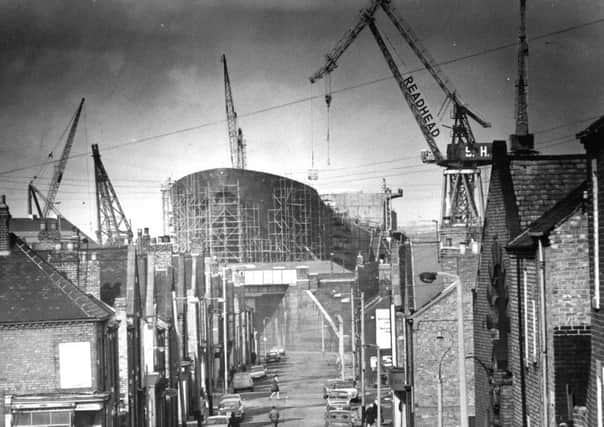Remembering the days of work at Readhead's


Today historian John Bage, who worked there, recounts the story of the yard and some of the people who were employed there.
“In 1880, John Readhead bought a site at West Docks, South Shields, for his new shipyard,” says John.
Advertisement
Hide AdAdvertisement
Hide Ad“The company was very successful and employed about 2,000 workers on average and had an excellent reputation with ship owners for the quality of their ships.
“The company celebrated its centenary in 1965 but in 1968 the yard was absorbed into the Swan Hunter Group which itself was nationalised as part of British Shipbuilders in 1978. The yard eventually closed in 1982, by which time the company had built nearly 600 vessels.
“Today the remaining buildings are owned by Port of Tyne. The Engine Works building was recently demolished and all that remains now is the sad and forlorn-looking Shipyard Technical Office building.
“This building was originally a tavern, long before its conversion to offices by Readheads.
Advertisement
Hide AdAdvertisement
Hide Ad“The lower floor was used by Readheads for the Steel Drawing Office, the middle floor was the Design and Estimating departments and the top floor accommodated the Outfitting and the Electrical Drawing Offices. In the basement was the Print Room and the plan storage.
“Having watched about 460 ship launches, this old building could probably tell us some wonderful stories and fortunately I have been able to gather a few myself during my research of John Readhead’s shipyard and its wonderful history, including the time on April 16, 1920, the King and Queen visited the shipyard.”
John said his own memories of Readheads come from when he started there on August 17, 1964.
“My memories of working in the Shipyard Drawing Office are all good and I was fortunate to work with some very nice people.
Advertisement
Hide AdAdvertisement
Hide Ad“I was able to take photographs of people and ship launches which then became the basis for my shipyard website in later years, some of which are included alongside this article.
“One person who contacted me with his memories of Readheads was Bill Stephenson who had worked there as a draughtsman from 1942. He had some interesting stories to tell and I have included some of them here.
“He begins with details of the people he worked with, including Laurie Brown, who was a draughtsman and ex professional footballer; Desmond Cook, assistant chief draughtsman and an ex County Champion swimmer, Mavis Baxter, who was a tracer and was ex-dockyard and Army.”
Bill also talks about Jimmy Walker, who was a draughtsman and also a good guitar player and John Parker, another draughtsman and an artist.
Advertisement
Hide AdAdvertisement
Hide AdBob Watson was the Office Plan man. Bill says he was a great guy, a local cricketer, football referee and a master chess player.
“Mavis Baxter came into the Tracing Office after she had completed her stint in the forces,” says Bill. “She had previously worked in Readhead’s Graving Dock Offices. She became a very good tracer.”
Bill recalls that she was a “whiz” at calculating the steel weights for the ship.
“Each steelwork plan included the material lists for all the requirements for steel plates, angles and bulb angles. With her plate-tables and boxwood section slide-rule, Mavis compiled everything in tons, cwts., qtrs. and lbs.
“I’m sure she could add up two columns at a time.”
Advertisement
Hide AdAdvertisement
Hide AdBill believes Bob Watson was in the coal mines as a young man.
“He left school at a very early age and was self-taught, and he was a very clever man.
“He could put his hand on almost any plan in the plan storage room, no matter how old the vessel was. He knew something about everything.
“He was a terrific chess player. When on fire-watching duty at the shipyard during the Second World War everyone there would play chess. Bob played against many of the managers. They were never pleased to be ‘polished-off’ by a ‘mere Plan Man’.
Advertisement
Hide AdAdvertisement
Hide Ad“‘Watson doesn’t play chess, he just takes your men off’, was their complaint.
“He was an excellent football referee and a good cricketer. He captained the team which included Mr Heckles the Chief Draughtsman and Director. Bob was a ‘one off’”.
Bill remembers being given an unusual job while he was at Readheads.
“One day the Chief Draughtsman, Mr Heckels said ‘Billy I want you to go over to the spare ground opposite the yard. Here’s a sketch. We are going to build a new Pipe and Plumber’s Shop. I want you to mark and lay-out the foundations.
Advertisement
Hide AdAdvertisement
Hide Ad“‘Go to the Loft and see the Foreman Loftsman. He’s got a 100ft tape, chalk, string line, pegs and battens, and one of the shipwrights will give you a hand’.
“Bill duly collected all these things together, met the shipwright, and together they set off for the site.
“The shipwright asked: ‘Have you ever marked-off and laid out the foundations for a building before?’
“Bill said he hadn’t. But the shipwright said: ‘We’ll be alright. I laid-out the whole of South Shields promenade.’
Advertisement
Hide AdAdvertisement
Hide Ad“We were alright. The job was completed in no time at all and the new building went up absolutely plumb, thanks to his expertise.
“A good example of the wonderful versatility of the shipyard worker.”
Tomorrow John and Bill tells us more about Readhead’s and the experiences of those who worked there.